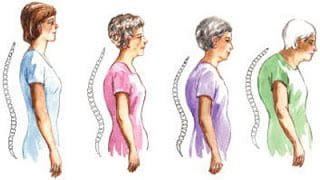
How to treat hunchback (and what causes it to begin with)
You may know it as a “Dowager’s Hump”…or simply hunchback. You may think it only affects senior citizens. The reality is that hunchback, or hyperkyphosis as it is professionally called, is affecting more and more people of varying ages. I often get asked about how to treat hunchback and if there is anything that can be done to prevent it.
Understanding hyperkyphosis (hunchback)
Physicians refer to the chronic, forward-leaning posture as hyperkyphosis. This condition is characterized by a rounding of the upper spine into a C-shaped curvature. If you have poor posture, over time you can develop an abnormal curve of the upper thoracic vertebrae and a sometimes a mass of tissue at the lower part of your neck. Typically, you have a head forward posture and loss of the normal cervical curve.
The severity of the condition can vary as can the symptoms, including:
- rounded shoulders or a hump on the back
- back or neck pain or stiffness
- feeling of head being too heavy or fatigued muscles in the back or neck
- tension headaches
Both men and women are susceptible, with an increased occurrence during middle-age.
What Causes Hunchback
 Bad posture is the most common cause. You’ve heard me talk about posture before and how much it impacts your health. With the increased use of smartphones, tablets and laptops, many people are in a slouched head forward position for hours a day, not to mention if their desktop computer is not set up ergonomically correct.
Bad posture is the most common cause. You’ve heard me talk about posture before and how much it impacts your health. With the increased use of smartphones, tablets and laptops, many people are in a slouched head forward position for hours a day, not to mention if their desktop computer is not set up ergonomically correct.
With a hunchback condition, your head is jutting forward, putting a lot of stress on the base of your neck. How much stress? Well, for every inch your head protrudes forward from its normal alignment, an extra 10 pounds of force is placed on your neck! Studies show that a loss of cervical curve as well as hyperkyphosis can reduce conductivity of the spinal cord as well as reduce lung capacity!
Poor posture can also develop from:
- slouching or hunching, such as at a computer or in front of a TV
- leaning back in chairs
- carrying heavy loads on your back, such as a backpack full of books
If you develop hunchback from poor posture, the condition can often be corrected through exercise and practicing good posture. Some individuals develop more severe hyperkyphosis as a result of:
- Compression fractures/osteoporosis
- Congenital problem
- Loss of postural muscle tone with aging – it’s estimated that 20 to 40 percent of older adults have hyperkyphosis.
Maintaining good posture is the best way for you to prevent hunchback. Core-strengthening exercises can be beneficial too.
Stretches to treat hunchback
Depending on your age and the severity, you can improve or reverse your hunchback. The key is to strengthen the upper back muscles as well to reduce the head forward posture and restore the cervical curve. Increasing muscle tone helps pull back the shoulders and put the head back on top of the shoulders. Just understand that even with practicing good posture and doing specific exercises, hunchback won’t go away overnight. It may take months of effort. And waiting too late to deal with it could mean that you’ll never completely get rid of it.
These exercises are excellent for improving your condition…but they are great preventatives too!
Chin tuck
Hold your head level, tuck your chin slightly and bring your head back directly over your shoulders (like you are a cobra about to strike). This is not an up or down movement, it’s straight back, so your nose should not tip down but stay level. You can do this exercise just about anywhere to help with your posture. Do chin tucks in sets of ten, rest and repeat.
Upper back stretch
Face a wall and place your hands flat against it above your head. Keeping your neck neutral, sink down into the stretch, being sure not to let your head drop as you’re doing this stretch. Keep your ears in line with your shoulders. After about 10-20 seconds, sink further into the stretch. Repeat several times.
Wall pushups
Again, face a wall with your hands head-level and shoulder width apart. Do a traditional push-up, making sure not to let your chin drop. You’ll feel the scapula in your back come together as you lean towards the wall. Do pushups in sets up ten, take a break, then do another set.
Finally, as an augment to exercises, we highly recommend this wedge, which we sell in our office. The Apex Premium with Heat counteracts forward head posture to help relieve headaches and neck pain. The wedge not only provides better support but also moist heat therapy. Patients rave about it! It’s well worth the $35 investment.
If you’d like some help getting started with treating hunchback at home or wonder if chiropractic treatments can aid the reversal (they can), please reach out and make an appointment to meet with myself or Dr. A.
Dr. Sharman

